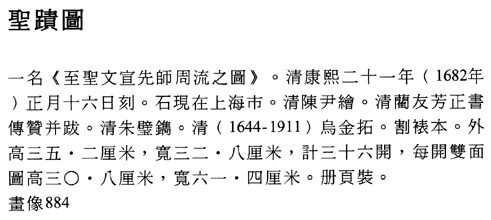 |
|
|
 |
|
|
Pictures of the
Sage's Traces Qing
dynasty (1644�1911), Kangxi period (1662�1722), dated and engraved 1682 Illustrated
by Chen Yin; eulogies and colophon composed by Lin Youfang; engraved by Zhu Bi Album of 72 leaves (36 double leaves), ink rubbed on paper; overall dimensions: 35.2 x 32.8 cm; each double leaf: approx. 30.8 x 61.4 cm Date
of rubbing not given, Qing dynasty (1644�1911) Inventory number: Huaxiang 884 Since
the earliest version of the Sheng ji tu (Pictures of the Sage's
Traces) was commissioned in 1444 by Zhang Kai (1398�1460), there have been many
recensions in terms of media (stone engravings, prints, paintings, and so
forth), number of episodes (ranging between 29 and 112 pictures), and formats
(principally handscrolls or albums).�
Incised-stone versions, from which infinite sets of ink rubbings could
be made, were the preferred mode.� Such
morally instructive illustrations, in contrast to the more familiar iconic
portraits of Confucius, were meant to help ordinary people visualize and
understand his teachings. The
version of 1682 contains 36 pictures drawn by Chen Yin, inscribed by Lin
Youfang, and engraved by Zhu Bi.� The
tablets were kept at the seat of Qingpu County in Songjiang Prefecture.� All of Chen Yin's oblong compositions
contain figures, but the scenes vary considerably among outdoor settings,
interior architectural spaces, or a combination of both.� In almost every picture a sense of dynamic
asymmetry prevails, with the text block in the corners and strong geometric
lines used to delineate architectural elements or interior furnishings. |
 |